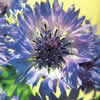Description ▲

This is an annual or biennial plant, native to southeastern Europe that spread later by the rest of the world. Cornflower can reach a height of three feet, presenting a rather stiff stem, with lanceolate leaves and flowers grouped with a beautiful deep blue color on the outside and darker color in the center.
The cornflower prefers moist soils and is easy to find with cereal crops, in vacant lots, embankments, roads and trails. In the Iberian Peninsula is found preferably in the northern half.
The plant blooms in the second half of spring, collecting only peripheral flowers, from late spring to midsummer.
Composition ▲
Cornflower contains a bitter substance in addition to cyanine, a cyanidin glucoside. In metabolic plant extract have been isolated several alkaloids (moschamine, cis-moschamine, centcyamine and cis-centcyamine)[1].
An experimental study cited below, found that the flower heads contain polysaccharides which include galacturonic acid, arabinose, glucose, rhamnose and galactose[2].
Properties and traditional uses ▲
Classically, cornflower or tile has been used as a diuretic, in dyspepsia and as a component of beverages in form of infusion. However, the more widespread use of this plant has been for the treatment of inflammatory ocular conditions, in form of eye drops or eye wash or only to clarify the vision, especially in the elderly. In some places it has been pursuing a decoction of flowers of cornflower and chamomile in form of compresses for tired eyes
Clinical studies ▲
There is no relevant information till this date.
Safety of use ▲
There is no relevant information about it. So, available data are insufficient to support the safe use of Centaurea cyanus
Experimental studies ▲
This plant has very few experimental studies. The anti-inflammatory effect has been highlighted in a study with a classical model (edema caused by carrageenan and croton oil). The authors also claim that the plant inhibits the hemolytic activity of plasma, inhibits the action of the anaphylatoxin and interferes with complement[2].
References ▲
1: Sarker SD, Laird A, Nahar L, Kumarasamy Y, Jaspars M. Indole alkaloids from the seeds of Centaurea cyanus (Asteraceae). Phytochemistry. 2001 Aug;57(8):1273-6.
2: Anti-inflammatory and immunological effects of Centaurea cyanus flower-heads. Garbacki N, Gloaguen V, Damas J, Bodart P, Tits M, Angenot L. J Ethnopharmacol. 1999 Dec 15;68(1-3):235-41.
Date upgrade December 20, 2010
WARNING ABOUT THIS CONTENT
The information contained in this website does not replace professional advice and guidance from the attending physician, to whom you should consult before making decisions about your health problems. MEDIZZINE cannot warrant or assume any responsibility for the accuracy or comprehensiveness of the information provided. Conversely, MEDIZZINE recognizes that the information provided is not exhaustive and, therefore, does not expose all of the available information and, in any case, cannot replace information and criteria that your doctor may provide you.